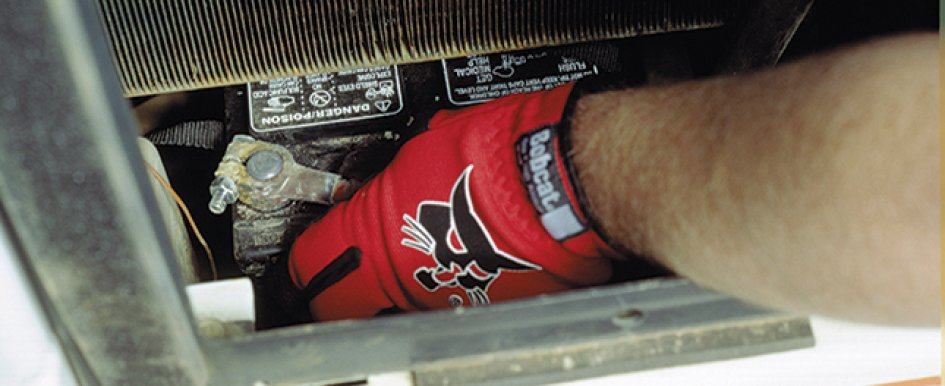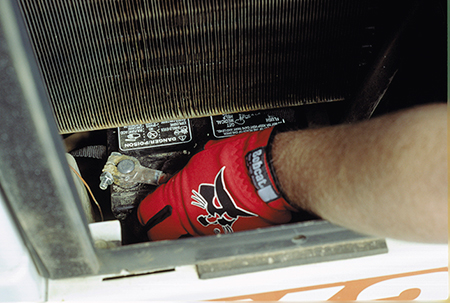
The most commonly operated compact machines in winter are skid-steer loaders. Their compact size, attachment versatility and pushing and lifting performance make them a popular choice for snow and ice removal.
Skid-steer loaders assigned to construction jobsites in warm or hot working months often transition to snow removal in late fall or early winter, especially with the help of various time- and labor-saving attachments.
To ensure your equipment is ready for the coming cold-weather months, follow these four simple steps to be better prepared for another winter.
Step 1: Read the owner’s manual
A skid-steer loader owner’s manual typically has a checklist of seasonal maintenance items, as well as oil and fluid recommendations, to help ensure you’re following the proper procedures to operate the loader in winter.
The owner’s manual should instruct you to check the following machine components and items:
- battery
- fluids
- oils and fuels
- tire pressure
- heating and defrosting systems
Step 2: Add the correct fluids
Cold temperatures can affect compact equipment in different ways, and one of the most important areas of consideration is fluids.

If a skid-steer loader does not have the proper engine oil, engine coolant, hydraulic oil and fuel for operating in cold weather, it may not perform to the operator’s standards. Refer to your owner’s manual for instructions on filling your machine with the correct fluid in the correct increments.
A machine also must have an engine oil viscosity that matches the outside operating temperature, especially for extremely cold weather. A block heater will help keep the machine’s engine warm, making it easier to start while
reducing wear on engine components. If your machine doesn’t have a block heater, consider purchasing and installing one this fall. Switch to a low-temperature grease for proper lubrication of the machine’s pivot points. Don’t forget to perform this important daily maintenance task.
Check and change hydraulic oil filters as needed. These filters collect water and debris during the busy spring, summer and fall construction seasons. Changing the hydraulic oil filter will help minimize future maintenance problems and downtime.
Engine coolant is an important fluid for compact equipment during winter operation. Check the engine coolant in your compact equipment to ensure it matches the manufacturer’s specifications.
If you operate compact equipment in far northern regions, you may want to consider an alternative diesel fuel and/or anti-gel additives. In extremely cold conditions, normal No. 2 grade diesel fuel can gel. Be sure you’re prepared before temperatures dip too low and you’re stuck with a machine that won’t run.
Today’s skid-steer loader engines burn cleaner and run hotter, even in cold months. It’s important for you or your equipment manager to be aware of oil and fuel selections to prevent downtime. Interim Tier 4 and Tier 4 engines require CJ-4 oil that has less ash content and minimizes issues with exhaust treatment systems. In addition to the required ultra-low sulfur fuel, additional filters on fuel storage and transfer tanks will help ensure clean fluids.
Step 3: Inspect tires, batteries and components
Be sure to properly inflate your compact equipment tires prior to operation in cold weather. Low tire pressure can cause lower lift and push capabilities, a bad combination for snow removal. Refer to your manual for the proper pounds per square inch (psi), and inflate the tires accordingly. Remind operators to keep a close eye on the tires and to check the pressure throughout winter.
Take time this fall to have your machine battery tested. Cold weather takes a toll on batteries, because it requires them to generate nearly twice as many cranking amps in order to turn over the engine and hydraulic and hydrostatic pumps. Pay close attention to the battery cables and connections for any wear or corrosion, because such defects could result in loss of available cranking power.
If your compact equipment has an enclosed cab with heat, inspect the heating and defrosting systems. These systems help to keep operators comfortable and maintain proper visibility through front, side and rear windows. Carefully check your cab’s door and window seals to ensure heat won’t seep out, and install a new windshield blade and antifreezing washer fluid. Also, be sure to replace any burnt-out bulbs to ensure your operators have the appropriate lighting when they are working at night.
Step 4: Examine attachments
Attachments such as angle brooms, snow blades, snowblowers, snow pushers and spreaders deserve the same attention as the carrier to which it’s connected.
Perform visual checks of attachment components such as hoses, cylinders and guards, and cutting blades and edges. Determine if wear is developing or if damage has occurred. Some attachments also require fluid-level checks and lubrication.
Prepare Your Excavators for Winter Applications
While operating compact excavators in cold weather may not seem like common practice, these machines are convenient for a variety of winter applications, including emergency water repairs, interior work and demolition projects. This checklist can help ensure your excavator is ready for winter.
- Inspect the battery and connections. Replace the battery as needed.
- Test engine coolant to ensure that it is properly proportioned to withstand the expected temperatures.
- Consider installing an engine block heater.
- Check the proper operation of the preheat system.
- Examine hydraulic hoses for damage that may have occurred during the summer.
- Keep the undercarriage as clean as possible to help avoid damage to the undercarriage components, especially if the machine is parked outside for extended periods.
